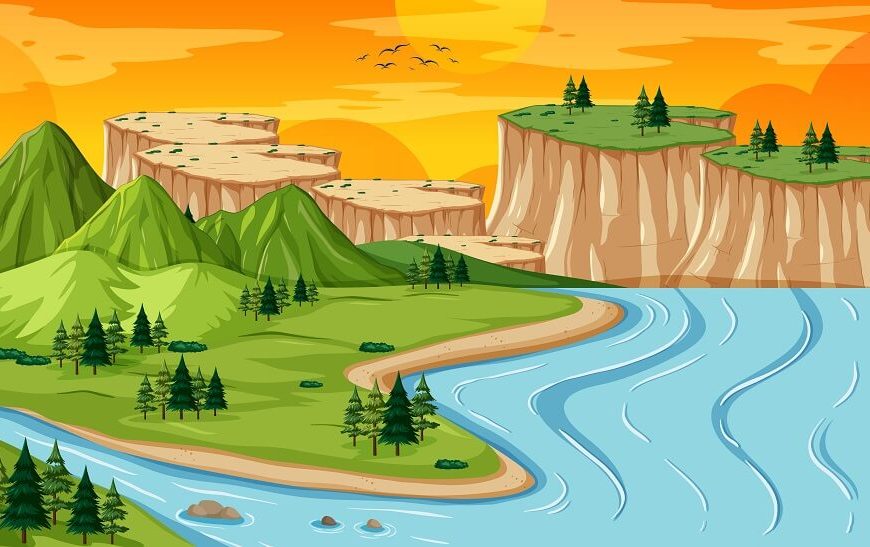Plateaus, those sprawling elevated lands that seem to touch the sky, are like nature’s high and mighty playgrounds. Both adults and children are enthralled with these distinctive geographic characteristics. We will go on an amazing exploration of plateaus in this comprehensive article, covering their definition, several varieties, and some fascinating trivia that will astound you about these amazing natural phenomena. In order to provide a more thorough grasp of the enchantment and majesty of plateaus, we will also go further into their formation, meaning, and human relationship.
What is a Plateau?
A plateau, pronounced ‘pluh-toe,’ is a unique geological landform that serves as a testament to Earth’s geological history. It is a flat, elevated area that rises sharply above the surrounding terrain on at least one side and is often referred to as a tableland due to its relatively flat top.
Types of Plateaus
Plateaus are diverse in size and form, frequently resulting from distinct geological processes. Now, let’s examine the three main kinds of plateaus that exist worldwide:
Volcanic Plateaus:
Volcanic plateaus are formed when volcanic eruptions spew forth molten lava and ash. These materials pile together over time to produce a surface that is level or gently sloped. Famously sculpted by the Deccan Traps’ eruptions, the Deccan Plateau in India is an example of a volcanic plateau.
Tectonic Plateaus:
Tectonic plateaus are the result of the tectonic movement of the Earth. Because of tectonic plate collisions or separations, portions of the Earth’s surface may rise and form plateaus. The raising of the Colorado Plateau province created the amazing tectonic plateau known as the Colorado Plateau in the United States.
Dissected Plateaus:
Dissected plateaus are those that have, over time, been worn down by ice, water, and wind. A great example of this kind of plateau is the Appalachian Plateau in the eastern United States. Because of the ways in which erosion has shaped it, it seems rough and steep.
Fascinating Plateau Facts
Now that we’ve covered the types of plateaus, let’s explore some fascinating facts about how these elevated wonders impact both nature and human activity.
A Playground for Adventure:
Plateaus are often sought-after destinations for adventurers and hikers. With their flat terrain, stunning vistas, and cooler temperatures, they provide a perfect playground for those who love the great outdoors.
Home to Unique Wildlife:
Many plateaus, particularly in remote areas, are havens for unique and sometimes endangered wildlife. These highlands provide habitats for a variety of species adapted to their challenging environments.
Water Sources:
Plateaus often serve as a source of life-giving water. Many rivers and streams originate from plateau regions, providing water for millions of people and animals downstream.
Climate Variation:
Due to their elevated nature, plateaus often experience cooler temperatures than the surrounding lowlands. This leads to diverse ecosystems, ranging from forests to grasslands and even deserts.
Archaeological Treasures:
Some plateaus are dotted with ancient archaeological sites. The Mesa Verde National Park in the United States, situated on the Colorado Plateau, is renowned for its well-preserved Ancestral Puebloan cliff dwellings.
Unique Rock Formations:
Plateaus often feature distinctive rock formations, such as mesas and buttes, which are created through the processes of erosion. Monument Valley in the United States is famous for its striking examples of these formations.
Agricultural Powerhouses:
Many plateaus are fertile and serve as agricultural powerhouses. The Plateau of Castile in Spain is known for its vast wheat fields and vineyards.
Formation of Plateaus:
Numerous unique geological processes lead to the formation of plateaus. Although we have already covered the most common types of plateaus, it is important to remember that certain plateaus are the result of a complex mix of many activities. Each plateau symbolises a unique era in Earth’s history due to its intricate geological past.
Environmental Significance:
Plateaus play a crucial role in maintaining ecological balance. Their elevated terrain can create microclimates, influencing weather patterns and precipitation. This impact extends far beyond their borders, affecting regions both nearby and thousands of miles away. Some plateaus, such as the Brazilian Plateau, act as natural water towers, providing fresh water for agriculture and human consumption.
Additionally, plateaus are often rich in mineral resources. Mines on plateaus yield valuable materials like iron, coal, and copper, which are essential for industrial processes worldwide. However, sustainable resource management is necessary to ensure that these unique environments are not irreversibly harmed.
Human Connection:
Throughout history, people have been drawn to plateaus for their unique attributes. The flat terrain often makes them ideal locations for human settlement. Cultures have thrived on plateaus, building cities and communities that endure through the ages. The Ethiopian Highlands, for instance, are known for their fertile plateaus, which have supported agricultural civilisations for millennia.
Moreover, plateaus have inspired artists, writers, and poets. The striking landscapes, intricate rock formations, and the interplay of light and shadow make plateaus artistic masterpieces in themselves. Monument Valley, located on the Colorado Plateau, has been the backdrop for countless films, its iconic buttes and mesas featured in many classic Western movies.
Conservation and Preservation:
Preserving plateaus and their unique ecosystems is of paramount importance. As urbanisation and development continue, plateaus are increasingly at risk. Conservation efforts aim to protect these areas and their biodiversity. National parks, like Mesa Verde in the United States, and UNESCO World Heritage Sites, such as the Harz Plateau in Germany, have been established to safeguard the natural and cultural significance of plateaus for future generations.
Adventure Awaits:
For the adventurous souls among us, plateaus are a treasure trove of exploration. Hiking, rock climbing, and mountaineering opportunities abound. The Tibetan Plateau, with its vast expanses of untouched wilderness, calls to those who seek the thrill of high-altitude adventures.














